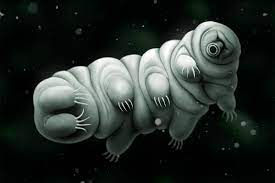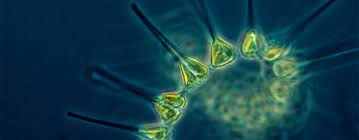Tardigrades
-
Can survive in almost all environments, most vulnerable to heat (100 degrees F), water (aquatic)
-
Consume bacteria, algae, plant cells as food source
-
900 known species
-
Can live indefinitely
-
Enter process called Cryptobiosis (death-like state), also called Tun.
-
Metabolism slows to 0.01 of normal
-
-

Phytoplankton
-
Common, thoroughly studied bacterium
-
Occurs in most environments, thrives in high temps (37+°C) and shade
-
Rely on carbon for production of biomass/growth (can largely use CO2 from environment as resource)
-
In ideal environment, replicating in ~20 min

E. Coli

Research
-
Common, thoroughly studied bacterium
-
Occurs in most environments, thrives in high temps (37+°C) and shade
-
Rely on carbon for production of biomass/growth (can largely use CO2 from environment as resource)
-
In ideal environment, replicating in ~20 min
Key Interactions
Tardigrades: consume phytoplankton as nutrient resource, consume E. coli and/or their byproducts
E. coli: compete with phytoplankton for nutrients (CO2, N, etc), population regulated by Tardigrade cultivation
Phytoplankton: compete with E. coli for nutrients (CO2, N, etc), consumed by Tardigrades
Sources
Tardigrades:
http://cshprotocols.cshlp.org/content/2018/11/pdb.prot102319.long
https://www.americanscientist.org/article/tardigrades
https://www.nature.com/articles/176121b0
https://www.livescience.com/indestructible-tardigrades-cannot-survive-heat.html
https://link.springer.com/article/10.1007/s00248-017-1134-4
Phytoplankton:
https://oceanservice.noaa.gov/facts/phyto.html
https://en.wikipedia.org/wiki/Phytoplankton
https://www.sciencedirect.com/science/article/pii/S0043135421011465
https://royalsocietypublishing.org/doi/10.1098/rspb.2011.0160
E.coli:
https://www.tandfonline.com/doi/abs/10.1080/02
https://www.ncbi.nlm.nih.gov/pmc/articles/PMC8694108/757549808035544
https://www.ncbi.nlm.nih.gov/pmc/articles/PMC3105702
https://www.sciencedirect.com/science/article/pii/S0043135421011465
https://biolabtests.com/top-facts-ecoli/
https://www.nature.com/articles/nbt1103-1266b#:~:text=E.,at%20about%2037%20%C2%B0C